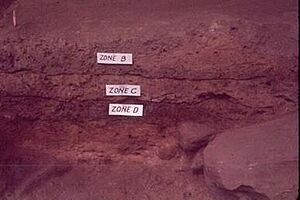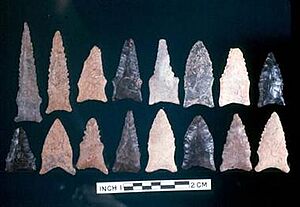Stanfield-Worley Bluff Shelter facts for kids
The Stanfield-Worley Bluff Shelter is a very important prehistoric site in Colbert County, Alabama, United States. It's a rock shelter where ancient people, called Paleo-Indians, once lived. Archeologists have found many clues here about how these early Americans lived. The shelter is located in Sanderson Cove, a protected area with high bluffs. This made it a safe and good place for Native American groups to live long ago.
This special rock shelter is considered a strong candidate to become a National Historic Landmark. This means it's recognized as a place of great importance to the history of the United States.
Contents
Discovering Ancient History at Stanfield-Worley
Archeologists have found evidence that people lived at the Stanfield-Worley Bluff Shelter for a very long time. They were here from the Paleoindian Period all the way to the Mississippian period. This covers about 9,000 years! The ground at the shelter has many layers, like a cake. Each layer, called a stratigraphic zone, holds clues about different groups of people who lived there. These layers help us understand how early societies in northern Alabama changed over thousands of years.
The Dalton People: Early Hunter-Gatherers
One important layer is called the Dalton zone. It shows us about a group of early Americans from around 7000 BCE. This was a time when people were transitioning from being Paleo-Indians to what archeologists call the Archaic period. Scientists used radiocarbon dating to figure out how old these items are.
The Dalton people were hunter-gatherers. This means they moved around to find food, hunting animals and gathering plants. Archeologists found over 150 projectile points in this zone. These were tips for spears or darts. They also found other tools like scrapers and knives. These tools were used for tasks like preparing animal hides or cutting food.
The tools found here include both older Paleo-Indian styles and newer Archaic styles. This shows the Dalton people were changing their ways. They also made tools from wood, antler, and bone.
The Stanfield-Worley Bluff Shelter is special because it has well-preserved animal and plant remains. These remains help us understand what the Dalton people ate and what their environment was like. They hunted animals like deer, squirrel, turkey, and even porcupines. Interestingly, porcupines don't live this far south today. They also found bones of the extinct passenger pigeon. While the Dalton people hunted similar animals to later groups, they didn't seem to collect shellfish or process seeds, which were common activities for later Archaic societies.
Later Occupants: Middle Archaic to Mississippian Times
Above the Dalton zone, archeologists found other layers. One layer, called Zone B, has items from the Middle Archaic period. In this layer, they found three sets of human remains, along with more projectile points and bone awls (tools for making holes). The very top layer, Zone A, contained items from the Archaic period all the way up to the Mississippian period. This shows the shelter was used by many different groups over thousands of years.
Exploring the Past: Archeological Digs
How Archeologists Studied the Shelter
Archeologists started digging at the Stanfield-Worley Bluff Shelter in 1960. They got permission from the landowner, Robert B. Stanfield. The project was a team effort by the Alabama Archaeological Society, the University of Alabama, and the Archaeological Research Association of Alabama. The first two years of digging were led by David L. DeJarnette and his team. A smaller dig happened in 1963, but those results were never fully published.
The archeologists used a method called the "trench and block" technique. Imagine dividing the dig site into squares. They dug trenches around these squares, creating blocks of earth. This allowed them to see the different layers of soil and artifacts clearly. The picture at the top of this article shows these trenches and blocks. From these digs, they collected over 11,000 items!
Why Stanfield-Worley Bluff Shelter is Important
By 1960, experts knew that northern Alabama had many important Paleo-Indian sites. The Stanfield-Worley Bluff Shelter was one of these key sites. It helped archeologists figure out the exact age of Dalton projectile points. Because of this, the site is mentioned in almost every book about early North American history.
The digs in 1960 alone found over 150 projectile points. This gave scientists a lot of information about many early cultures in Alabama. The points were sorted into many different types. Much of this valuable information was included in the Handbook of Alabama Archaeology.
Many experts, like Robert E. Bell and Charles H. Fairbanks, praised the North Alabama project. They said it was very successful in raising money to support more archeological research.





